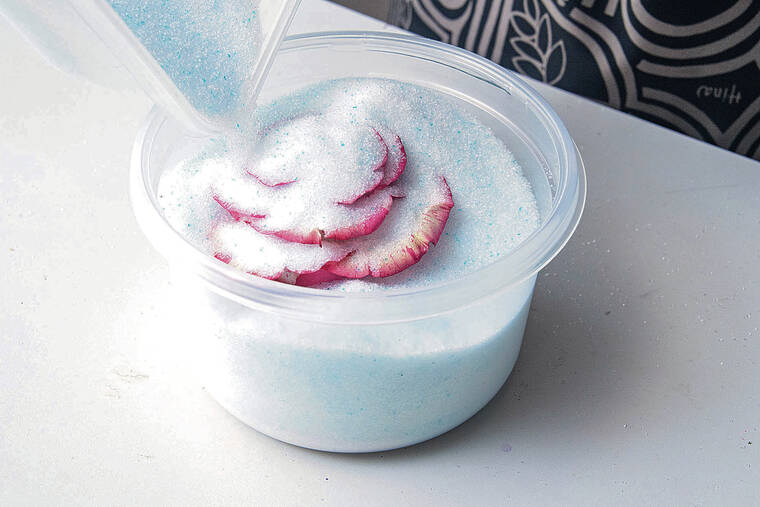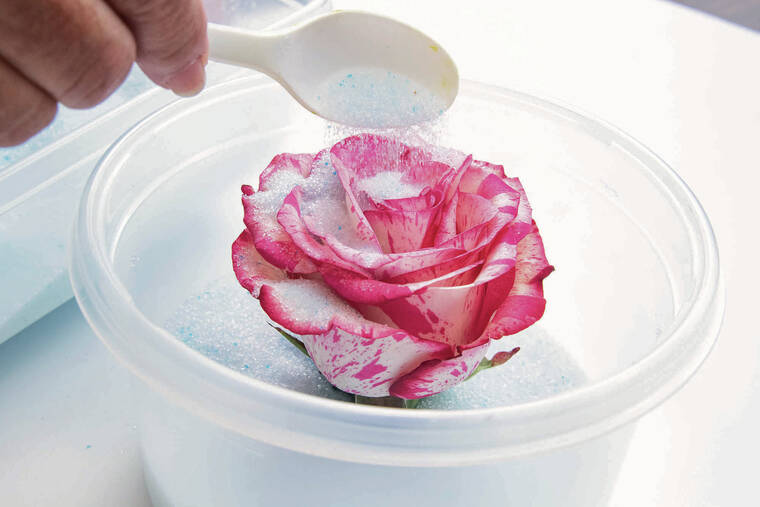How to prolong the beauty of Valentine’s Day arrangements

CRAIG T. KOJIMA / CKOJIMA@STARADVERTISER.COM
Burying flowers in grains of silica gel is a fast way to dry them and retain the color longer. In a plastic container with a lid, stand the flower upright in a layer of silica on the bottom and gently spoon it between the petals. Keep it in the sealed container away from the sun for seven to 10 days.

CRAIG T. KOJIMA / CKOJIMA@STARADVERTISER.COM
Burying flowers in grains of silica gel is a fast way to dry them and retain the color longer. In a plastic container with a lid, stand the flower upright in a layer of silica on the bottom and gently spoon it between the petals. Keep it in the sealed container away from the sun for seven to 10 days.

CRAIG T. KOJIMA / CKOJIMA@STARADVERTISER.COM
Kjori Murakami arranged a rose bouquet Monday at Watanabe Floral Inc. The florist expects to create over 1,700 classic red rose Valentine’s arrangements.



Splurging on flowers for Valentine’s Day stems from the heart, and the sentiment brings big business to the floral industry. It produces over 250 million roses for the occasion, according to the Society of American Florists.
With a dozen red roses easily going for $100 or more on Valentine’s Day, every lucky lady (or gent) who receives these timeless tokens of romance will want to make them last as long as possible.
Monty Pereira, general manager of Watanabe Floral Inc., passed along a few tips to keep these flowers from fading for several days, and longtime teacher Joy Shimabukuro of Ben Franklin Crafts shared how to preserve a bouquet for years to come by drying or pressing them.
Fresh flowers
Pereira said most florists treat the water in the vase with a preservative, which ensures a rose’s longevity. Just add fresh water to the arrangement every day as the flowers drink it up.
>> Keep the vase at least two-thirds full of water in an area that’s not near heat or directly under a fan or air-conditioning vent. Roses should last four to six days under good conditions, the red ones lasting the longest (over pastel colors) because they’re bred for longevity, he said.
Don't miss out on what's happening!
Stay in touch with breaking news, as it happens, conveniently in your email inbox. It's FREE!
>> Cut at least one-half inch off the bottom of the stem at an angle once the flower starts to droop so it can absorb more water before it gets totally dehydrated. The easiest way is to grab hold of the entire bouquet from the vase and clip off the ends instead of taking each rose out of the arrangement and trying to stuff it back in between the bunch of filler greenery, said Watanabe floral designer Kjori Murakami.
>> Remove all the leaves from a stem below the waterline to reduce bacteria in the water.
>> For bunches of roses purchased without a vase, cut the stems as soon as you get home. Add a packet of preservative, but if it’s unavailable, make sure to change the water every day to minimize bacteria growth, Pereira said.
Dried/pressed mementos
Dried roses and flowers make wonderful keepsakes of special occasions or events, said Shimabukuro, who has demonstrated different techniques for 20 years on The Joy of Crafting on Spectrum OC 16. For instance, a great memento of graduation day would be a few dried flowers from each lei received, framed with a photo of the graduate wearing the fresh lei, she suggested.
>> The most organic way to dry roses is simply to hang the bouquet upside down in a cold, dark and dry place, such as a cabinet or closet, for several weeks to retain their color and remove the moisture.
>> For a faster way that also retains the rose color longer, Shimabukuro recommends burying the flowers in grains of silica gel. Get a lidded glass jar or air-tight plastic container, and cut a few of the stems down to about 2 inches so they fit. (If you want to preserve all the roses, you may need additional containers.) Stand the flowers upright in a layer of silica on the bottom and carefully fill in the space around the flowers with silica, gently spooning it between the petals. Close the container and keep it away from the sun for seven to 10 days. Avoid moving the container.
Ben Franklin sells a flower-drying product made by Activa Products that comes in a 5-pound bag for about $40, which is reusable for future projects.
>> If you want to dry out the flowers even faster, put the glass jar or air-tight plastic container with the top OFF in the microwave with 1 cup of water in the back of the microwave, she said. Depending on the amount of flowers being dried, microwave on medium heat for one to three minutes, using a chart available at activaproducts.com Opens in a new tab.
>> Pressing roses is even simpler, she said: Place the flowers flat between two pieces of paper towel or any absorbent paper; place between two heavy books for several days or longer. Remove the dried flowers carefully with tweezers to make cards or frame as art to hang on the wall.
Pressed flowers can also be made into jewelry, keychains or charms with silica molds that are fast and easy to make; workshops are available at BenFranklinHawaii.com Opens in a new tab.
—
Roses, by the thousands
After candy and cards, roses are the third most popular gift nationwide for Valentine’s Day, which is the busiest single holiday at Watanabe Floral Inc. in terms of quantity and dollars, says general manager Monty Pereira.
The romantic occasion is also the store’s biggest “male-dominated purchase holiday,” with 90% of the flowers bought by men, Pereira said. (Mother’s Day is the biggest female-dominated one, as there are more daughters buying flowers for their moms and other relatives than their husbands, he said.)
As the largest floral shop in the state, Watanabe’s main showroom on Nimitz Highway is also one of the largest florist locations in the U.S., he said.
Having worked at Watanabe Floral for 25 years, also as its sales manager, Pereira can recite Valentine’s Day numbers by heart:
>> For the period from Feb. 10 to 15, the company will bring in 150,000 stems of all colors this year, of which 60% to 70% are classic red.
>> Total arrangements (of all flower types) will number about 3,000 over the six days; of this total, over 1,700 will be of the classic red roses.
>> The price of arrangements starts at $119 for 12 extra-long red roses; there are options for two and four dozen roses at varying prices. An unarranged bunch of 25 roses sells for $1.50 to $2 a stem; pastels are cheaper, reds are at a premium price.
>> Watanabe averages 2,000 deliveries over Feb. 10 to 15, though about 1,300 of them will occur on Monday and Tuesday (the actual holiday) this year. All 25 vans will be deployed, each staffed by a driver and delivery person.
Normally the company schedules 55 staff for a shift at the showroom, but it brings in another 50 to 70 employees just for this holiday, mostly for delivery.
—
Watanabe Floral Inc.
1618 N. Nimitz Hwy.
Info: 808-832-9360 or watanabefloral.com Opens in a new tab
HouseMart/Ben Franklin Crafts
Various locations



